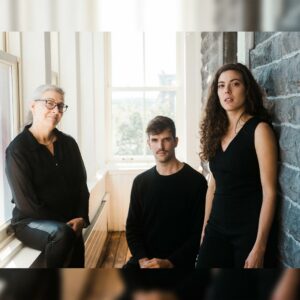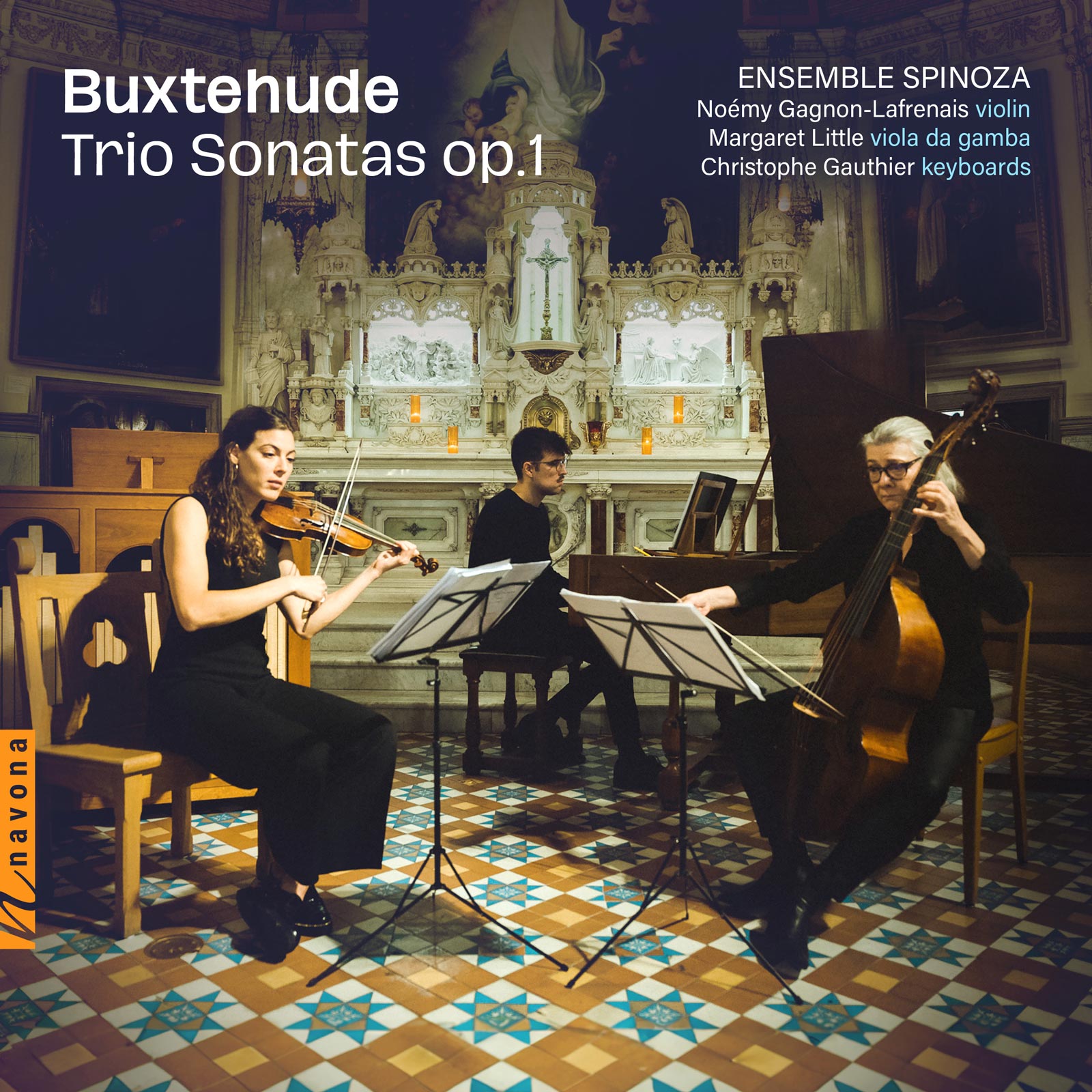Buxtehude
Ensemble Spinoza
Noémy Gagnon-Lafrenais violin
Margaret Little viola da gamba
Christophe Gauthier keyboards
BUXTEHUDE Trio Sonatas op.1 is the debut album of Québécoise violinist Noémy Gagnon-Lafrenais, who joins forces with viola da gambist Margaret Little and keyboardist Christophe Gauthier to form Ensemble Spinoza and celebrate the seminal work of 17th-century composer Dietrich Buxtehude.
VII Suonate a due, violin & viola da gamba, con cembalo Op.1. highlights Buxtehude’s distinctive compositional style and stands as a testament to his contribution to the instrumental repertoire of the Baroque era. Featuring North German, French, and Italian influences, the music is an aesthetic masterpiece of musicological significance. Through its historically informed performance, Ensemble Spinoza gives a thoughtful and heartfelt reading of each of the beautiful sonatas in this collection.
Listen
Stream/Buy
Choose your platform
Track Listing & Credits
| # | Title | Composer | Performer | |
|---|---|---|---|---|
| 01 | Trio Sonata No.1 in F Major, BuxWV 252 | Dietrich Buxtehude | Ensemble Spinoza | Noémy Gagnon-Lafrenais, violin; Margaret Little, viola da gamba; Christophe Gauthier, keyboards | 9:43 |
| 02 | Trio Sonata No.2 in G Major, BuxWV 253 | Dietrich Buxtehude | Ensemble Spinoza | Noémy Gagnon-Lafrenais, violin; Margaret Little, viola da gamba; Christophe Gauthier, keyboards | 7:46 |
| 03 | Trio Sonata No.3 in A minor, BuxWV 254 | Dietrich Buxtehude | Ensemble Spinoza | Noémy Gagnon-Lafrenais, violin; Margaret Little, viola da gamba; Christophe Gauthier, keyboards | 10:32 |
| 04 | Trio Sonata No.4 in B-flat Major, BuxWV 255 | Dietrich Buxtehude | Ensemble Spinoza | Noémy Gagnon-Lafrenais, violin; Margaret Little, viola da gamba; Christophe Gauthier, keyboards | 8:44 |
| 05 | Trio Sonata No.5 in C Major, BuxWV 256 | Dietrich Buxtehude | Ensemble Spinoza | Noémy Gagnon-Lafrenais, violin; Margaret Little, viola da gamba; Christophe Gauthier, keyboards | 8:54 |
| 06 | Trio Sonata No.6 in D minor, BuxWV 257 | Dietrich Buxtehude | Ensemble Spinoza | Noémy Gagnon-Lafrenais, violin; Margaret Little, viola da gamba; Christophe Gauthier, keyboards | 9:10 |
| 07 | Trio Sonata No.7 in E minor, BuxWV 258 | Dietrich Buxtehude | Ensemble Spinoza | Noémy Gagnon-Lafrenais, violin; Margaret Little, viola da gamba; Christophe Gauthier, keyboards | 7:36 |
Recorded in 2022 at Église Saint-Augustin de Mirabel, Québec, Canada
Recording Session Producer and Engineer Carl Talbot, Musicom Productions
Recording Session Engineer and Editing Philippe Bouvrette, Musicom Productions
Mastering Marc Thériault, Le Lab Mastering
Photography by Adil Boukind
![]()
Executive Producer Bob Lord
A&R Director Brandon MacNeil
A&R Danielle Sullivan
VP of Production Jan Košulič
Audio Director Lucas Paquette
VP, Design & Marketing Brett Picknell
Art Director Ryan Harrison
Design Edward A. Fleming
Publicity Chelsea Kornago
Artist Information

Ensemble Spinoza
Ensemble Spinoza is a Montreal based early music ensemble. It was co-founded by Noémy Gagnon-Lafrenais and Christophe Gauthier in 2020. Acclaimed gambist Margaret Little joined the ensemble in 2021. The group specializes in the performance of 17th century baroque on period instruments. The ensemble’s mission is to uncover hidden gems of the repertoire and make them available to North Americans. Ensemble Spinoza stands apart through its profound artistic contemplation, embodying a pursuit of knowledge that echoes the philosophers from whom it draws its name.

Noémy Gagnon-Lafrenais
The québécoise violinist Noémy Gagnon-Lafrenais enjoys exploring repertoire through the filter of historically informed practice. Pursuing the quest for a genuine and creative expression of music, she spends much time wondering and wandering about the past!
In 2021, Gagnon-Lafrenais was appointed concertmaster of Arion Orchestre Baroque. She is the artistic director and cofounder, with Christophe Gauthier, of Ensemble Spinoza.

Margaret Little
Born in Montreal into a family of musicians, Margaret Little learned to play the violin, piano, recorder, and guitar at a young age. She also participated in a children’s choir and occasionally played the electric guitar in a band. At the age of 11, she discovered the viola da gamba and it was love at first sight! Her father, organist and choir conductor George Little, had a deep passion for the works of J.S. Bach. A wonderful teacher, he is a great source of inspiration for his colleagues and a pioneer of early music in Canada. Starting at the age of 9, Margaret began playing Bach’s cantatas on the violin under her father’s direction. Even today, she plays them on the viola whenever she has the opportunity.

Christophe Gauthier
Born in Montreal, Christophe Gauthier studied at the Conservatoire de Montréal (Mireille Lagacé) and he did his Bachelors (Réjean Poirier) and Masters (Luc Beauséjour) at Université de Montréal. He also took classes with Benjamin Alard (Paris) and Jory Vinikour (Chicago).
A talented chamber musician, Gauthier has founded many ensembles such as Les Rendez-vous baroque français, The Opus Project, and Ensemble Spinoza.
Notes
First published in Hamburg in 1694, Dietrich Buxtehude’s VII Suonate a due, violino & viola da gamba, con cembalo Op.1 stands as a testament to his remarkable contribution to the instrumental repertoire of the Baroque era. The collection highlights Buxtehude’s distinct style of composition, which was shaped by his creative ingenuity and his exposure to a diverse range of European music in the latter half of the 17th century. Born in Denmark in 1637, Buxtehude became organist and Werkmeister at St. Mary’s Church of Lubëck in 1688. The city thrived as a prominent maritime center during the period of the Hanseatic League. It can be inferred that Buxtehude had access to a rich array of musical resources and influences, which transpire through the Opus 1 sonatas.
Each of the sonatas within this opus contains extensive contrapuntal and fugal sections which are punctuated by slower modulatory sections — a practice inherited from the North German organ music tradition and the stylus fantasticus. Elements of French instrumental music can also be discerned, most especially in Sonata No. 5. It employs a less contrapuntal texture and incorporates rhythmical figurations reminiscent dance movements such as the Sarabande and the Gigue. In contrast, Sonata No. 6 seems to be strongly inspired by the Italian style, with Buxtehude clearly writing in the stylus fantasticus, almost frantically alternating between moments of introspection and outward joy. Later in the sonata, he even alludes to the famous Folia dance. Interestingly, the seven sonatas are each written in a different key — arranged linearly from F Major to E minor — in a language that skillfully mixes tonality and modality and allows a full range of effects to be expressed. Ultimately, the Op. 1 Sonatas offer an insight into Buxtehude’s remarkable musical aesthetic, which celebrates the diaspora of human emotions.

